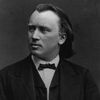Orchestra Association of the Society of Friends of Music in Vienna
The orchestral association of the Gesellschaft der Musikfreunde is the oldest amateur orchestra in Vienna .
history
The association was founded in 1859, making it the oldest amateur orchestra in Vienna. The Society of Friends of Music , founded in 1812, consisted of so-called "performing members" as well as supporting members. They played concerts with conductors and soloists. After a change in the statutes, the orchestra club finally got its own identity as a branch of the Gesellschaft der Musikfreunde.
The tradition of the orchestral association goes back to a time when the word 'dilettante' was not yet a dirty word. Rather, it meant the actual artist who, in contrast to the professional musician, plays free of charge and only out of love for music. As a pillar of musical culture in the 19th century, amateurism was part of the identity of the Society of Friends of Music. This is documented not least by the fact that in the course of history, to the delight of its members, a number of important artists have made music with the orchestra. Among them are Johannes Brahms , who worked as a conductor and pianist, the violinist Arnold Rosé , the court opera singer Elisabeth Schumann , the conductor Lovro von Matacic , the pianists Jörg Demus , Paul Badura-Skoda , Ingrid Haebler , Mitsuko Uchida and, in recent history, the Double bass player Ludwig Streicher , the violinist Ernst Kovacic , the Altenberg Trio , the Artis Quartet and the soprano Ildikó Raimondi . On the other hand, it is also part of the club's philosophy to get young artists onto the podium. These included the 16-year-old violinist Henryk Szeryng in 1934 and the pianist Alfred Brendel in 1956 . In 2004 the 19-year-old pianist Ingolf Wunder was invited to play the solo part of the Tchaikovsky Concerto. Six years later he won second prize in the international Chopin competition .
In addition to Robert Zelzer , who has directed the ensemble since the 1990s, conductors such as Raphael Schlüsselberg and Marta Gardolińska have also been invited to guest conductors.
As important as the role of this orchestra was in Viennese musical life in the 19th and early 20th centuries, the orchestra had to face the increasing competition between professional orchestras and the more sophisticated technology of sound carriers. The associated change in values - the LP and now the CD replaced house music - threatened the existence of the orchestral association in the 1992/93 season. It was only through the merger with another Viennese amateur ensemble, the Gersthofer Chamber Orchestra, that the tradition of music-making and public appearances was continued.
Historical photos
present
Today almost all age groups and many professional groups are united in this body of sound. In this way, apart from performing several times a year at home and abroad, the orchestral association was able to return to the large music association hall . The success of these concerts meant that it has been a tradition since the 1990s to perform at least once a year in the Golden Hall . There are also invitations to concerts by various organizers. A highlight in 2012 was the collaboration with the Singverein der Gesellschaft der Musikfreunde , the second branch of the Society, which took place for the first time in decades : Joseph Haydn's "Creation" was performed in the Golden Hall as part of a gala concert to mark the bicentenary of the Gesellschaft der Musikfreunde.
While the programs were limited to works from the Baroque to the Romantic period , the orchestra today also dares to perform works of the 20th century and contemporary music . In the summer of 2003, a work by Fritz Keil, which he had composed on behalf of the orchestral association, was premiered.
The Academic Wind Philharmonic Orchestra has been cooperating with the Orchestra Association since autumn 2004, thereby opening up new dimensions of sound for the orchestra and expanding the possibilities of program design. In this way, works could be realized that are not a priori on the program of an amateur orchestra, such as B. Ludwig van Beethoven's 9th symphony, Anton Bruckner's symphonies 4, 5 and 7, Gustav Mahler's 1st and 2nd symphonies, Camille Saint-Saëns ' organ symphony, Dmitrij Shostakovich's 5th symphony. In addition, contributors became members of the orchestra association.
literature
- Wolfgang Schubert: The orchestral association of the Society of Friends of Music in Vienna. Hamburg 2009 (Studies in Musicology Vol. 18) ISBN 978-3-8300-4874-9
- Manfred Merk: Reach for the stars . In: Musikfreunde - Journal of the Society of Music Friends Vienna, March 2011


